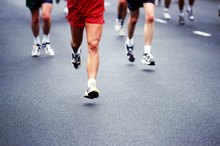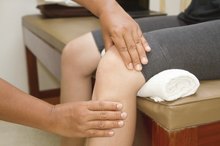How to Increase Flexion After Total Knee Replacement
According to the American Academy of Orthopaedic Surgeons (AAOS), over 580,000 total knee replacement surgeries occur every year in the U.S. Common reasons for a total knee replacement include osteoarthritis, rheumatoid arthritis, and injuries. Though the AAOS says that over 90 percent of total knee replacement surgeries result in favorable outcomes, in terms of pain reduction and activity performance, this is a complex surgery that requires careful consideration. A crucial aspect of rehabilitation following any total knee replacement surgery involves increasing knee flexion.
Use a continuous passive motion (CPM) machine every day for the first several days following surgery. Georgetown University Hospital's total knee replacement protocol suggests using CPM for 4 hours a day, increasing the amount of flexion 10 degrees at a time until you can easily attain 90 degrees of knee flexion.
How to Massage a Knee After Total Replacement
Learn More
Perform heel slide exercises on the affected knee. While the knee is bent, slide the heel back toward your hips as far as the pain will allow. Orthopaedic surgeon Charles Abrahamsen suggests starting these exercises in a supine position, lying on your back, and performing 2 sets of 20, 3 times per day. You can also perform this exercise while sitting on a chair or on the edge of the bed.
Use a stationary bike to increase knee flexion once you reach 90 degrees of flexion, explains Dr. Abrahamsen. Begin with the seat in a raised position and with no resistance, then gradually lower it to increase knee flexion as your pain permits, cycling 1 to 2 times per day for 10 to 15 minutes each session.
Taping Techniques for Morton's Neuroma
Learn More
Perform knee flexion stretches. Orthopaedic surgeon Howard Luks suggests that while sitting on the floor or elevated treatment table, loop a towel under your heel, then pull the ends of the towel toward your chest. Stop when you feel a strong stretch, and hold the position for 15 seconds. Return to the starting position and repeat for 3 to 5 repetitions.
Ask your surgeon about manipulation under anesthesia. If your knee flexion remains limited, Dr. Robert Namba and Maria Inacia explain in the Journal of Athroplasty that manipulation of the knee under anesthesia results in increased knee flexion following total knee replacement surgery.
Warnings
Always check with your surgeon before performing any exercises following a total knee replacement.
Related Articles
References
- American Academy of Orthopaedic Surgeons: Total Knee Replacement
- Arbab D, Reimann P, Brucker M, Bouillon B, Lüring C. Alignment in total knee arthroplasty - A comparison of patient-specific implants with the conventional technique. Knee. 2018;25(5):882-887. doi:10.1016/j.knee.2018.05.017
- Wang H, Foster J, Franksen N, Estes J, Rolston L. Gait analysis of patients with an off-the-shelf total knee replacement versus customized bi-compartmental knee replacement. Int Orthop. 2018;42(4):805-810. doi:10.1007/s00264-017-3622-z
- Zeller IM, Sharma A, Kurtz WB, Anderle MR, Komistek RD. Customized versus Patient-Sized Cruciate-Retaining Total Knee Arthroplasty: An In Vivo Kinematics Study Using Mobile Fluoroscopy. J Arthroplasty. 2017;32(4):1344-1350. doi:10.1016/j.arth.2016.09.034









